SEA LEVEL REFUGEES
By Johannes Luetz
There could be 200 million “climate change refugees” by 2050, according to a new policy paper (1) by the International Organization for Migration (IOM). Aside from islands in the South Pacific and low-lying coastal countries like Bangladesh, the problem is also likely to hit home in the Maldives, where President Mohamed Nasheed recently announced the creation of a sovereign wealth fund to buy new land elsewhere should rising sea levels inundate the country and necessitate a forced relocation. There is no denying it: “climate change refugees” have joined the list of looming climate change issues, and the problem is increasingly filtering through to the public.(2)
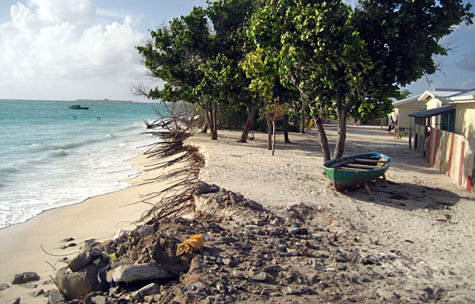
Erosion is a big problem on the recently settled island of Dhuvaafaru. According to local eyewitnesses, in one week (May 2009) the west monsoon surges claimed 20 feet of land. Islanders have piled up rubble in an attempt to slow down the advancing ocean and protect their houses.
A few weeks ago I came to the Maldives to orient myself about the looming “climate change refugee” problem as part of a PhD project. (3) During a brief visit I enjoyed numerous positive encounters with policy makers, NGO workers, and local atoll islanders. Time and space constrain me to limit my observations to three challenges and possible remedies. These snapshot impressions may fail to be comprehensive but I hope that they can nonetheless serve as useful guiderails on the country’s path to a friendly and feasible future:
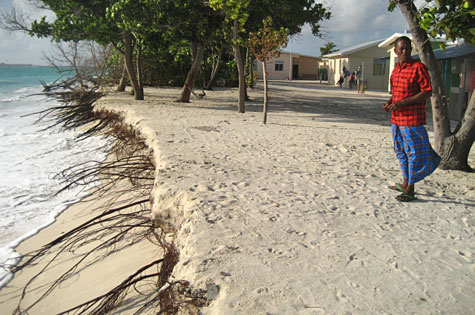
Easa Mohamed (52) moved to Dhuvaafaru on 10 December 2008. He is concerned that the island’s bad erosion problem could soon force him to abandon his brandnew house (pictured on the far right).
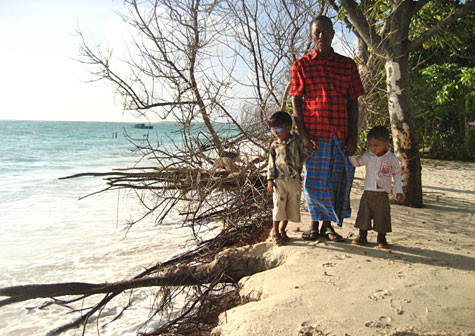
Easa Mohamed (52) with two of his grandchildren, Mohamed Yamin (left) and Abdulla Rizan (right). He says unless the coastline is reinforced, next year’s west monsoon surges are bound to wash his house into the sea.
1. BUILD UP : My brief visit to the recently resettled island of Dhuvaafaru reinforced my conviction that “elevated islands” are critical if infrastructural investments are to be successfully protected. Let me explain. After Kandholudhoo was devastated and rendered uninhabitable by the 2004 Indian Ocean Tsunami, millions of dollars were pumped into the blueprint development of Dhuvaafaru: thousands of trees were felled; hundreds of houses were constructed; community centres were built; health facilities were established; schools were designed; state-of-the-art equipment was put in place (including high-tech desalination plants and 24/7 power generators). Altogether multiple millions of dollars were invested to facilitate the resettlement of 4,000 tsunami relocatees to their new island home. In the face of accelerating sea level rise and worsening erosion these infrastructural investments are now increasingly at stake. While erosion has always been part and parcel of daily life for thousands of islanders the world over, climate change and related rises in sea level have begun to increase and intensify land loss in many parts of the world. (4) The Maldives is no exception. Once infrastructure is locked in place, it is too late to elevate an island to a higher baseline level. Only time will tell how many years remain until low-lying Dhuvaafaru succumbs to the nibbling sea. I offer that any effort to maximise on time and money should see low-lying islands elevated first, and costly infrastructure built up second. This will not prevent sea level from rising, but it will buy more time. (Hulhumalé is a case in point.)
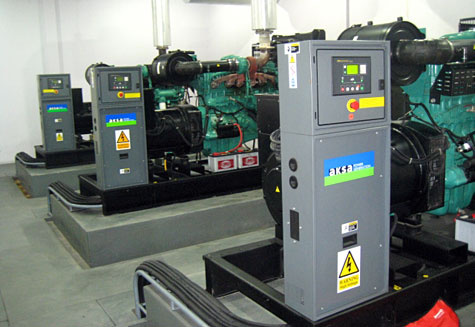
Brandnew diesel generators on the Island of Dhuvaafaru. This power house generates continuous (24/7) power supply and burns more than 1,000 litres of diesel fuel each day (i.e., 33,000 litres per month, 396,000 litres per year). CO2 emissions on that order of magnitude represent a significant obstacle to the Maldives’ ambitious plan to become the world’s first carbon neutral country.
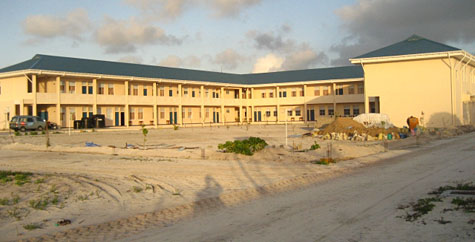
Expensive infrastructural investments like these brandnew buildings on Dhuvaafaru are increasingly threatened by sea level rise and erosion. Once elaborate infrastructure is locked in place, it is too late to raise an island to a safer (“elevated”) height. Advance safety measures generally represent a large saving in terms of avoided losses and reconstruction costs, and should be viewed as a way of lowering the overall costs of economic development. Prioritising preparedness protects progress.
2. TEAM UP : Despite some valid criticism levelled at Dhuvaafaru by individual islanders about their new houses or town layout (5), in many ways the relocation of an entire island populace numbering thousands of people from Kandholudhoo to Dhuvaafaru can be regarded as a remarkable achievement. As I traversed the width and breadth of the newly populated island of Dhuvaafaru, I was thrilled to see that the demographic planners had evidently succeeded to maintain the cohesion of the entire island community. In fact, in the face of global climate change, rising seas, and the looming resettlement of millions of future “sea level refugees” (6) to new homelands, I was impressed to see that the island community had been corporately resettled from one place to another rather than dissolved and absorbed into the social fabric of multiple other island communities. On the contrary, its integrity and societal unity had been successfully safeguarded and maintained! And it showed. Despite the brandnew locality everybody already seemed to know everybody else — the harmony and familiarity between the islanders was clearly evident. This fact in itself makes Dhuvaafaru a fascinating case study. In the event that a doomsday sea-level-rise-scenario should eventually render small island states uninhabitable, refugee resettlement plans should invariably include measures to ensure the ongoing sovereignty, unity, integrity and cultural identity of affected island communities. This is a key success factor, and Dhuvaafaru is a case in point.
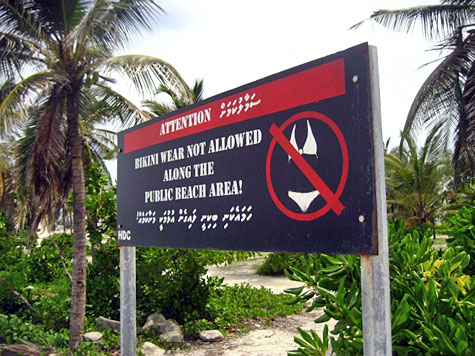
“Bikini wear not allowed along the public beach area!” A big notice-board on Hulhumalé advocates proper beach wear. Similar signs could advocate proper trash disposal and environmental protection.
3. CLEAN UP : A somewhat more sobering impression was the amount of trash I observed in parts of the country. While travelling by speedboat I watched as half a dozen local passengers threw nonbiodegradable trash overboard (plastic bottles, Milo drink containers, plastic wrappers, etc). Nonbiodegradable waste — as the word suggests — is “non”biodegradable, i.e., it does not decay in the water. Instead, nonbiodegradable waste floats forever in the sea, tossed to and fro by the ocean currents, until it finally washes up on some shore. And it showed. In numerous places I was saddened to see the natural beauty of the Maldives tarnished by raw garbage, either bobbing up and down, floating in turquoise waters, or washed up on formerly pristine beaches. On the island of Hulhumalé I spotted a big bill-board which advocates proper beach wear: “Bikini wear not allowed along the public beach area!” I thought to myself that similar signs could advocate proper trash disposal and environmental protection. Moreover, additional rubbish bins could be set up to help keep the Maldives clean (I repeatedly found myself hard-pressed to find a rubbish bin where to discard my emptied water bottles, etc). Why is cleanliness important? Simple. A rising ocean progressively reduces the amount of available land. As time goes by, more and more people will share less and less land. Hence it is pivotal to make the best possible use of the available land and maintain the highest possible hygienic standards for the wellbeing of both people and biosphere.
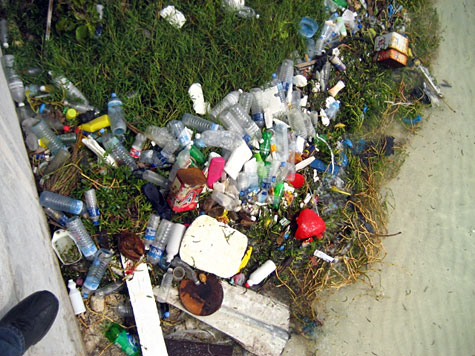

Garbage washed up on the shores of Hulhumalé. Nonbiodegradable waste does not decay in the water.
In summary I offer one final point. Efforts to protect the biosphere are usually conceptualised as an additional cost. In fact, one of the principal arguments often used to justify a lack of progress in environmental protection is that developing countries have other priorities, e.g. economic development, and cannot afford the additional costs of protective measures. (7) I would like to volunteer a contrasting view. Investment in safety measures and environmental protection generally represents a large saving in terms of avoided losses and reconstruction costs, and should be viewed as a way of lowering the overall costs of economic development. In the short run, building up “elevated islands” prior to their infrastructural development costs additional time and money. In the long run, however, such protective measures will save more money (and buy more time!) than their initial investment cost. Safety measures and environmental protection are an investment, not a cost.
Johannes Luetz is the lead author of World Vision’s Asia Pacific Disaster Report ‘Planet Prepare’. He is currently conducting a research on ‘Climate Change Migration – Resettling Island Communities Displaced by Sea Level Rises’.
You can contact the author at planetprepare@gmail.com
All photographs by Johannes Luetz
NOTES
(2) http://www.nytimes.com/2009/05/29/world/29refugees.html
(3) Sea Level Refugees: People displaced by rising sea levels, the topic of my PhD research (“Sea Level Refugees: Opportunities And Success Factors For Controlled Climate Change Migration – Lessons From Present-Day Small Island Resettlements”). Contact me by e-mail for information on my PhD research: planetprepare@gmail.com
(4) See World Vision Asia Pacific Disaster Report “Planet Prepare” for more information on relocating coastal communities, including in Papua New Guinea and Bangladesh (124 pages, 8MB): http://www.wvasiapacific.org/downloads/PlanetPrepare_LowRes.pdf
(5) In a number of ways the houses on Dhuvaafaru reminded me of the tsunami survivor villages I visited some time ago along the western coast of Aceh Province, Indonesia. It is perhaps not surprising that such villages, often built by the international development community under significant time pressure, are prone to similar weaknesses. Criticism levelled at Dhuvaafaru during my visit (I repeatedly had to stress that I was not a representative of the IFRC) commonly addressed the following points: Many house entrances were designed to face west, which makes houses more vulnerable to sand, wind and rain entering in. Also some cultural and lifestyle needs were not properly taken into consideration such as fishing community-specific felt needs or the absence of corner shops (to buy basic household items people now have to walk long distances), etc. A better consultative process at grassroots level could have identified such potential flaws prior to the towns construction. This is especially important in the case of a slow-onset disaster like rising sea levels which allow more time for advance planning and preparation.
(6) Numerous studies have attempted to estimate the number of future climate exiles. One voice makes the point clear: “When we talk about a one metre rise in global sea level we are also talking about 500 million people who are going to have to look for new homes. So far we don’t have any instruments to manage this.†(Prof. Dr. Hans Joachim Schellnhuber, Director Potsdam Institute for Climate Impact Research, Chairman German Advisory Council on Global Change (WBGU), Senior Advisor to the German Government)
(7) See also Disaster Risk Reduction Global Assessment Report @ http://www.preventionweb.net/english/hyogo/gar/report/index.php

solah said,
June 20, 2009 @ 12:35 am
good with your project and thanks for your concern to the environment
Digital Signature Algorithm » Blog Archive » Greenland ice sheet said,
July 8, 2009 @ 10:43 am
[…] BLUEPEACE blog » SEA LEVEL REFUGEES […]
Norman Quinn said,
September 2, 2009 @ 11:01 am
Interesting read, but the observation of beach erosion is not necessarily a metric for climate change. On the contrary it is a nature process. Sand is constantly moved according to the season. In the NE monsoon the sand is blown back. Stroms sometimes cause bigger than usual waves that alter the shape of the islands.
Your observations about the effects on climate change to the Maldives are similar to the uninformed Maldivian who visits Europe in December and is shocked by all the dead trees and then warms of the effects of climate change on Europe.
Do science to back up your hypothesis. Work for your Ph.D.
BLUEPEACE blog » CELEBRATING 20 YEARS OF LOVE FOR THE ENVIRONMENT said,
September 13, 2009 @ 6:37 am
[…] Maldives cannot be underestimated. The issues of migration and adaptation, the scenario of becoming sea level refugees one day, and joining forces with the most vulnerable countries to combat climate change will be […]
nasiha said,
September 17, 2009 @ 1:14 pm
million thanks for doing this..